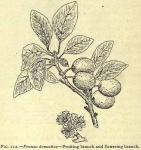 The partly dried ripe fruit of Pru'nus domes'tica Linné.
The partly dried ripe fruit of Pru'nus domes'tica Linné.
BOTANICAL CHARACTERISTICS.—The French variety, or Juliana, the principal commercial prune, bears ovate-oblong, deep-purple drupes, not depressed at the insertion of the stalk, and with a scarcely visible suture and no furrow; pulp greenish and rather austere. The tree is small, with smooth branches and elliptical leaves; flower-buds formed of one or two flowers; petals white, oblong-ovate.
HABITAT.—Western Asia; cultivated in temperate regions. Most of the prunes come from France, the best from Bordeaux.
DESCRIPTION OF DRUG.—Dried shriveled, oblong, almost globular, about 30 mm. (1 1/3 in.) long; externally brownish-black. The sarcocarp (the medicinal portion) consists of a brownish-yellow pulp having a sweet, acidulous taste, and surrounds a single stone (putamen), which is very hard, smooth or ridged, and incloses a white, bitter weed.
CONSTITUENTS.—Sugar 12 to 25 per cent., pectin, malic acid, and salts. The seeds contain fixed oil, amygdalin, and emulsin.
Preparation of Amygdalin.—Obtained by solvent action of boiling alcohol upon the "oil cake," evaporating off alcohol, fermenting residue by yeast, and precipitating amygdalin and gum. Boiling alcohol takes up the principle which is deposited on cooling.
ACTION AND USES.—Laxative and nutrient, as an article of food or in laxative confections.
Confectio Sennae (U.S.P. VIII). Dose: 1 to 3 dr. (4 to 12 Gm.).

